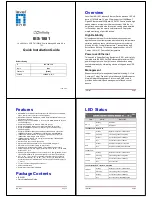
1-1
1
IPv6 PIM Configuration
When configuring IPv6 PIM, go to these sections for information you are interested in:
z
IPv6 PIM Overview
z
Configuring IPv6 PIM-DM
z
Configuring IPv6 PIM-SM
z
Configuring IPv6 PIM-SSM
z
Configuring IPv6 PIM Common Features
z
Displaying and Maintaining IPv6 PIM
z
IPv6 PIM Configuration Examples
z
Troubleshooting IPv6 PIM Configuration
The term “router” in this document refers to a router in a generic sense or a Layer 3 switch running IPv6
PIM.
IPv6 PIM Overview
Protocol Independent Multicast for IPv6 (IPv6 PIM) provides IPv6 multicast forwarding by leveraging
static routes or IPv6 unicast routing tables generated by any IPv6 unicast routing protocol, such as
RIPng, OSPFv3, IS-ISv6, or BGP4+. IPv6 PIM uses an IPv6 unicast routing table to perform reverse
path forwarding (RPF) check to implement IPv6 multicast forwarding. Independent of the IPv6 unicast
routing protocols running on the device, IPv6 multicast routing can be implemented as long as the
corresponding IPv6 multicast routing entries are created through IPv6 unicast routes. IPv6 PIM uses
the reverse path forwarding (RPF) mechanism to implement IPv6 multicast forwarding. When an IPv6
multicast packet arrives on an interface of the device, it is subject to an RPF check. If the RPF check
succeeds, the device creates the corresponding routing entry and forwards the packet; if the RPF check
fails, the device discards the packet. For more information about RPF, refer to
IPv6 Multicast Routing
and Forwarding Configuration
in the
IP Multicast Volume
.
Based on the implementation mechanism, IPv6 PIM falls into two modes:
z
Protocol Independent Multicast–Dense Mode for IPv6 (IPv6 PIM-DM), and
z
Protocol Independent Multicast–Sparse Mode for IPv6 (IPv6 PIM-SM).
















































